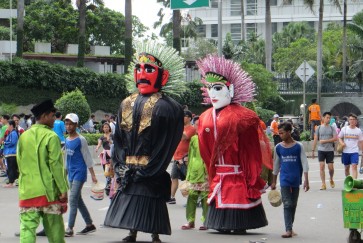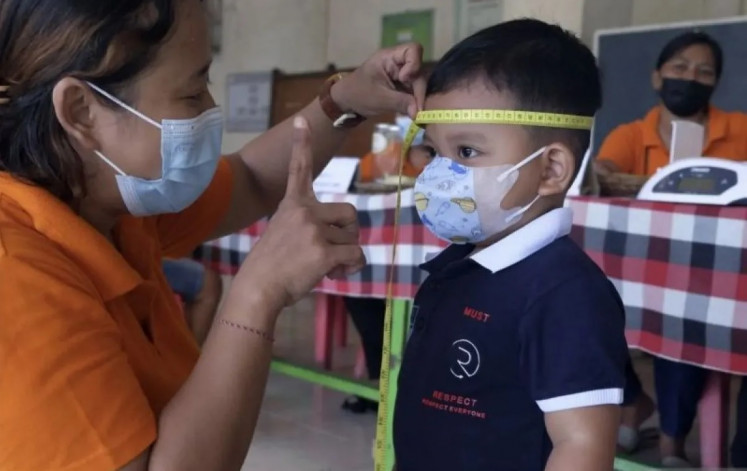Rewriting history: How Si Pitung ‘should’ be presented to youngsters
Old homestead: Boys play on the grounds of Rumah Si Pitung (Pitung’s House) in Marunda, North Jakarta, in 2014
Change text size
Gift Premium Articles
to Anyone

O
ld homestead: Boys play on the grounds of Rumah Si Pitung (Pitung’s House) in Marunda, North Jakarta, in 2014. The house, which was once owned by Pitung, a Betawi (Jakarta native) hero, is now a popular tourist spot in Jakarta.(JP/PJ Leo)
The legendary Betawi figure of Si Pitung should have his stories rewritten so that the narrative goes beyond Robin Hood-style heroism to reveal more about cultural identity and values.
The new narrative should help explore symbols of Pitung’s resistance to oppression rather than solely focus on the collective memory of the man himself.
Si Pitung, considered a hero by the Betawi people and dubbed the local Robin Hood, would steal from the wealthy landlords and share the riches with the oppressed poor during the Dutch colonial era.
But in the eyes of the Dutch, he was a criminal looting for his own benefit.
“The figure of Si Pitung was very important [during his era], making his story not solely a collective memory but a symbol of resistance to colonialism,” University of Indonesia (UI) historian Bondan Kanumoyoso said during a discussion titled “A narrative re-contextualization of Si Pitung: The Jawara [heroic figure] that remained good” at the Jakarta Maritime Museum in North Jakarta on Saturday.
He said Si Pitung was a controversial figure because many people had a different understanding of him.
“Si Pitung is highly popular among the Betawi people and Indonesians in general. We learn about his personage from history books, novels, children’s books and more. Thus, the narrative about him is diverse,” he said.
Si Pitung is believed to have been born in Rawa Belong, West Jakarta, in the 19th century, making him an inhabitant of the Ommenlanden, an extension area to the east and south of Batavia, now called Greater Jakarta.
His “patriotism” is believed to have slowly surfaced based on his own experience after money he had earned from selling goats was stolen while he was heading home. His father told Si Pitung to get back the money.
At the end of the 19th century, people living in the Ommenlanden were heavily impacted by modernization triggered by the industrial revolution, marked by the massive development of railways and roads that eventually opened access of Batavia to Ommenlanden, which was separated by walls.
The high crime rate in the Ommenlanden — a place already inhabited by people of multiple ethnicities — was mainly triggered by economic hardship and a lack of supervision by the Dutch, Bondan said, but the Dutch only realized this after modernization took place.
“Speaking about Pitung’s story is like speaking about unrevealed colonial policies,” he said. “His reputation has impacted local residents’ stance in seeing the daily problems they face, encouraging them to change their fate.”
“We have been waiting for a narrative with an original touch from the Indonesian people. This kind of narrative is the one we should fight for,” he added.
Speaking at the same occasion, UI lecturer Tommy Christomy from the School of Humanities suggested putting forward the featured characters of Si Pitung.
“From a cultural point of view, people need a narrative that represents the identity and pride of the community,” he said.
“Are we willing to transform the narrative even after it has passed the era?” he asked.
Thomas Ataladjar, an author of several history books on Batavia (but not about Pitung) who attended the event as a participant, expressed a similar opinion, emphasizing the lack of appreciation of the legendary figure.
“Think about why [Si Pitung] became the Dutch colonial ruler’s number one villain at the time?” he asked The Jakarta Post after the event.
He suggested the rewriting of the narrative by underlining why Si Pitung had been stealing, citing the socioeconomic conditions in Ommenlanden.
Thomas said he had seen many writers just agree with Si Pitung being depicted solely as a robber rather than exploring his setting, which happened during the cultuurstelsel (forced cultivation era) that had created a large social gap between the Dutch and Indonesian people.
“We need to dig deeper to explore that part,” he added.
Tommy said museums could play a leading role in starting to reconstruct the narrative.
“The museum is a very strategic place to reconstruct the narrative of what a nation expects from a figure,” he said. “A narrative is very ideological in representing the point of view of a group.”
Maritime Museum management head Bambang Ismadi said he supported the idea of rewriting the narrative on Si Pitung.
“Hopefully, not only the museum but also communities and the general public will want to get involved to think about [reconstructing the narrative of Si Pitung],” he told the Post after the event.









